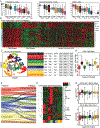Discovering dominant tumor immune archetypes in a pan-cancer census
- PMID: 34963056
- PMCID: PMC8862608
- DOI: 10.1016/j.cell.2021.12.004
Discovering dominant tumor immune archetypes in a pan-cancer census
Abstract
Cancers display significant heterogeneity with respect to tissue of origin, driver mutations, and other features of the surrounding tissue. It is likely that individual tumors engage common patterns of the immune system-here "archetypes"-creating prototypical non-destructive tumor immune microenvironments (TMEs) and modulating tumor-targeting. To discover the dominant immune system archetypes, the University of California, San Francisco (UCSF) Immunoprofiler Initiative (IPI) processed 364 individual tumors across 12 cancer types using standardized protocols. Computational clustering of flow cytometry and transcriptomic data obtained from cell sub-compartments uncovered dominant patterns of immune composition across cancers. These archetypes were profound insofar as they also differentiated tumors based upon unique immune and tumor gene-expression patterns. They also partitioned well-established classifications of tumor biology. The IPI resource provides a template for understanding cancer immunity as a collection of dominant patterns of immune organization and provides a rational path forward to learn how to modulate these to improve therapy.
Keywords: Pan Cancer analysis; immune profiling; solid tumor microenvironement; system immunology; tumor immunology; unsupervised clustering.
Copyright © 2021 Elsevier Inc. All rights reserved.
Conflict of interest statement
Declaration of interests M.F.K. is a founder and shareholder of PIONYR immunotherapeutic and FOUNDERY innovations. A.I.D. is a shareholder of Trex and Neuvogen, and he is also a member of the scientific advisory board of Neuvogen, Bristol-Myers and Squibb, Merck, Roche, Pfizer, Genentech, Incyte, Amgen, and Novartis. E.A.C. is a consultant at IHR Therapeutics, Valar, and Pear Diagnostics, reports receiving commercial research grants from Astra Zeneca, Ferro Therapeutics, Senti Biosciences, Merck KgA, and Bayer, and has stock ownership in Tatara Therapeutics, Clara Health, BloodQ, and Guardant Health.
Figures







References
-
- Asp M, Giacomello S, Larsson L, Wu C, Fürth D, Qian X, Wärdell E, Custodio J, Reimegård J, Salmén F, et al. (2019). A Spatiotemporal Organ-Wide Gene Expression and Cell Atlas of the Developing Human Heart. Cell 179, 1647–1660.e19. - PubMed
Publication types
MeSH terms
Substances
Grants and funding
LinkOut - more resources
Full Text Sources
Other Literature Sources
Medical
Molecular Biology Databases

